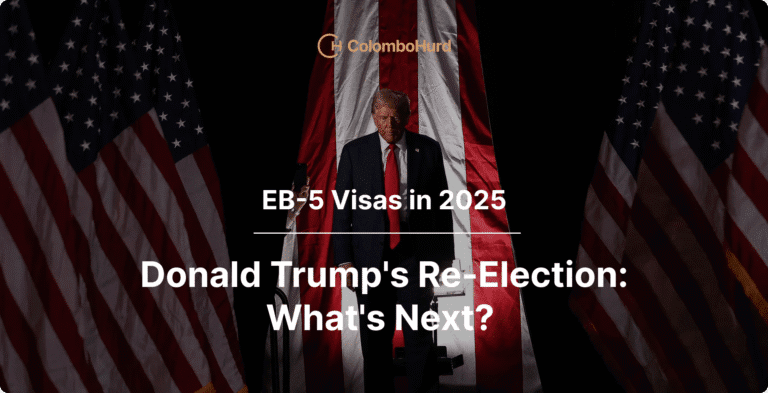Donald Trump’s return to the White House brings with it a renewed focus on economic growth, domestic job creation, and merit-based immigration. While the details of his administration’s approach to immigration remain to be seen, the Employment-Based Immigration: Fifth Preference (EB-5) Immigrant Investor Program is well-positioned to thrive under policies that emphasize economic contributions and job creation.
The EB-5 visa program has long been a cornerstone for foreign investors seeking residency through capital investment and job creation in the United States. As President Trump’s administration focuses on strengthening the U.S. economy, the EB-5 program aligns perfectly with his priorities, offering a mutually beneficial framework for both investors and the American workforce.
Outlook for EB-5 Under Trump
Historically, Trump’s policies have emphasized merit-based systems and the economic contributions of legal immigrants. This philosophy dovetails with the purpose of the EB-5 visa program, which requires applicants to make significant investments in U.S. businesses, thereby directly contributing to job creation and economic growth.
Trump’s pro-business stance, evidenced by his efforts to lower corporate taxes and reduce regulatory barriers during his previous term, created an environment conducive to economic innovation and foreign investment. By fostering a business-friendly atmosphere, his administration encouraged foreign entrepreneurs to pursue opportunities in the U.S., which naturally aligned with the goals of the EB-5 program.
The EB-5 program is uniquely positioned to benefit from this renewed emphasis on economic merit. Unlike family-based immigration categories, which have historically faced restrictions under Trump, the EB-5 visa directly ties immigration benefits to tangible contributions, such as creating or preserving at least ten full-time jobs for U.S. workers. This focus on measurable economic outcomes could make the program a key element of Trump’s immigration strategy.
Innovation and Confidence in EB-5
Trump’s policies could usher in a new era for EB-5 that prioritizes innovation, investment transparency, and operational efficiency. For instance, during Trump’s previous tenure, the SEC (Securities and Exchange Commission) actively targeted fraudulent EB-5 projects, reinforcing investor confidence in the program. This oversight, coupled with Trump’s commitment to economic growth, could lead to stronger safeguards and better outcomes for both investors and regional centers.
Historical Context and Policy Implications
During Trump’s previous term, the administration proposed reforms to shift U.S. immigration towards a merit-based system, drawing inspiration from countries like Canada and Australia. These proposals aimed to prioritize immigrants with skills and economic potential over family-based admissions. The EB-5 program inherently embodies this meritocratic approach, as it attracts investors capable of infusing substantial capital into the U.S. economy.
However, the administration also implemented policies that increased scrutiny across various visa categories. For instance, the denial rate for H-1B petitions rose to 24% in fiscal year 2018 and remained elevated at 21% in fiscal year 2019. This heightened scrutiny could extend to EB-5 applications, potentially leading to more rigorous evaluations and longer processing times. Nonetheless, such measures could enhance the program’s integrity by ensuring that only bona fide investors participate.
Potential for Program Enhancement
The administration’s pro-business stance, characterized by efforts to lower corporate taxes and reduce regulatory burdens, fosters an environment conducive to foreign investment. This climate could make the EB-5 program more attractive to international investors seeking stable and profitable opportunities. Moreover, the administration’s focus on infrastructure development and rural economic revitalization aligns with recent EB-5 reforms that reserve visas for investments in rural areas and infrastructure projects, thereby promoting balanced economic growth.
Challenges and Considerations
That said, potential challenges remain. Trump’s previous administration applied stricter interpretations of immigration policies, leading to increased scrutiny of visa applications across categories. If similar approaches are adopted for EB-5, applicants may face heightened due diligence requirements and more rigorous adjudication standards. However, this increased scrutiny could ultimately strengthen the program by ensuring that only credible and impactful projects are approved, further enhancing its reputation.
Additionally, visa availability and processing times remain critical factors for the program’s success. Advocates within the EB-5 industry will likely work closely with the administration to address these challenges, emphasizing the program’s economic benefits and its alignment with Trump’s broader goals.
Keep in mind that these predictions are based on President Trump’s past statements and his policies during his previous administration. While the specifics of Trump’s current stance on immigration and the EB-5 program are still unfolding, his administration’s policies will likely shape the program’s future.
Conclusion
President Trump’s re-election presents both opportunities and challenges for the EB-5 Immigrant Investor Program. The administration’s emphasis on economic growth and merit-based immigration aligns with the program’s objectives, potentially enhancing its appeal and effectiveness. However, stakeholders must be prepared to address increased scrutiny and navigate a complex regulatory environment. Engaging with experienced immigration professionals and staying informed about policy developments will be crucial for maximizing the program’s benefits in the coming years.





